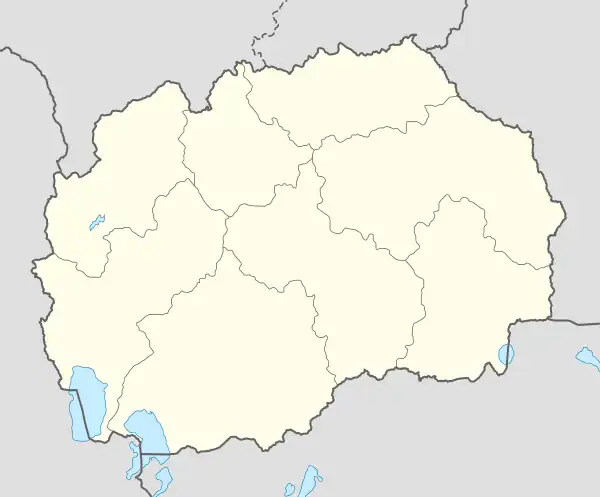Tauresium
Tauresium (Latin; Macedonian: Тауресиум), today as Gradište (Macedonian: Градиште), is an archaeological site in North Macedonia, approximately 20 kilometres (12 mi) southeast of the capital Skopje. Tauresium is the birthplace of Byzantine Emperor Justinian I (ca. 482) and King Theodahad of the Ostrogoths (480).[1][2]
 Remains of building walls in Tauresium | |
 Shown within North Macedonia | |
| Alternative name | Gradište |
|---|---|
| Location | Taor, Skopje Statistical Region, North Macedonia |
| Region | Dardania |
| Coordinates | 41°53′53″N 21°36′41″E |
| Type | Settlement |
| Site notes | |
| Archaeologists | Arthur Evans |
| Website | www |
Location and general characteristics

Tauresium is located in Zelenikovo Municipality, near the village Taor, some 20 kilometres (12 mi) southeast of Skopje. The site was discovered by British archaeologist Arthur Evans in the late 19th century. According to Justinian's biographer Procopius, the Emperor was born in Tauresium in 482, more precisely in the castle of Baderiana, which is near the modern village Bader.
In the book De aedificiis by Procopius he states:
"...Among the Dardanians of Europe who live beyond the boundaries of the Epidamnians, close to the fortress which is called Bederiana, there was a hamlet named Taurisium, whence sprang the Emperor Justinian, the founder of the civilised world. He therefore built a wall of small compass about this place in the form of a square, placing a tower at each corner, and caused it to be called, as it actually is, Tetrapyrgia. And close by this place he built a very notable city which he named Justiniana Prima (this means "first" in the Latin tongue), thus paying a debt of gratitude to the home that fostered him..."[3]
The similarity in the names of Taoresium and Barderia as Taor – Таор and Bader – Бадер was brought to attention by Antun Mihanović, the First Austrian Konzul 1836–1858 and proposed to the writer Hun, who stopped on his journey to investigate the location, which is noted in the book Stara Srbija i Makedonija – Spiridion Gopčević. The stories from the local peasants and badly damaged Cyrillic script were not sufficient to prove the theory initially, but later in the Monastery of St.John in Veles, Cyrillic writings were presented to him after which he concluded that this the same Byzantine City of Tauresium, birthplace of Justinian I who laid the foundation for The First Golden Age of The Byzantine Empire.[4]
Tauresium and the castle Baderiana were destroyed in an earthquake in 518 and the epicentre of the earthquake was in the nearby city of Skupi. As a gesture of gratitude to his birthplace, Justinian I rebuilt the city. According to the excavations that have been done so far, it is estimated that the oldest parts of Tauresium date from the 4th century and this oldest part is a castle with four towers known as Tetrapirgia. Regarding Baderiana, Procopius states that it "is a settled castle with oddments from the IV-VI century".[2] Baderiana or the modern Bader is located 6 km east of Tauresium and Taor.
References
- Wolfgang Kuhoff (1996). "Theodahadus, Flavius, König der Ostgoten 534-536". In Bautz, Traugott (ed.). Biographisch-Bibliographisches Kirchenlexikon (BBKL) (in German). Vol. 11. Herzberg: Bautz. cols. 824–832. ISBN 3-88309-064-6.
- "Archaeological site Tauresium" (in Macedonian and English). Museum of the city of Skopje. Archived from the original on 4 March 2011. Retrieved 26 January 2011.
- "The Buildings of Procopius".
- Gopčević, Spiridion (1890). Stara Srbija i Makedonija (in Serbian). Parna štamparija D. Dimitrijevića.
External links
- tauresium.info - web page dedicated to Tauresium.
